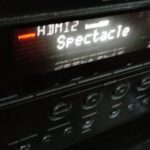Onkyo TX-NR6050 Review (Powerful 7.2 Channel Receiver)
Onkyo TX-NR6050 Review (Powerful 7.2 Channel Receiver)
The Onkyo TX-NR6050 is a fantastic 7.2 channel smart AV receiver; delivering 90W/ch of clear and powerful audio to your speakers. It supports stunning 4K & 8K resolutions, exciting gaming features, flexible sound customization, and even 7 HDMI slots — making it a great choice for a home theater.
Check Onkyo TX-NR6050 Receiver Availability
Are you looking for a powerful 7.2 channel AV receiver that handles the latest video & audio technologies?
One that plays up to 4K & 8K resolutions, works with up to 7 speakers, and even supports 3D sound?
Well in this Onkyo TX-NR6050 review, we’ll cover an awesome 7.2 channel smart AV receiver that does exactly that.
We’ll spotlight the features, capabilities, and performance of this exciting HDMI 2.1 enabled device.
Most importantly, we’ll be determining who this receiver is for, and if it’s the right one for you.
(Afterwards, be sure to check out these cool gift recommendations, of which, this receiver happens to be one of)
https://easyhometheater.net/25-awesome-home-theater-gift-ideas
Features
210 Watts Per Channel
With 210 watts per channel with 4 ohms speakers, or 90 watts when used with 8ohms speakers, it’s able to deliver incredibly powerful sound.
Support For 8K
With support for picture resolutions of up to 8K, the Onkyo TX-NR6050 can supply capable TVs with a beautifully clear image.
HDMI 2.1 Support
The fact that the NR6050 supports HDMI 2.1 means it can support the latest image formats like HDR and 8K; as well as high refresh rates like 4K120 & 8K60 with low latency for gaming.
eARC Support
Support for eARC (basically an HDMI pass through) makes setting up this receiver really easy with only needing an HDMI cable (as long as your TV supports eARC)
5.2.2 Support
This receiver has Dolby Atmos and DTS:X support, allowing you to have a 5.2.2 home theater setup.
AccuEQ Calibration
Through what Onkyo calls its AccuEQ calibration, it can account for room acoustics by automatically adjusting each speaker with its included mic for a more optimized sound
AccuReflex Calibration
The AccuReflex calibration adjusts phase timing of height & ceiling speakers making for a more immersive experience — with 3D sound formats like Atmos & DTS:X supported.
Sonos Certified
By being Sonos Certified, this receiver can work with Sonos Home Sound Systems & speakers via the Sonos Port and dedicated app.
Fast Streaming Speeds
The NR6050 has dual band 5GHz/2.4GHz wifi that adheres to the 802.11ac specification; basically making streaming content on it extremely fast.
Multi Zone Support
Utilizing zones, you can watch content on multiple displays simultaneously, even if they’re not located in the same room.
Check Onkyo TX-NR6050 Receiver Availability
Setting Up The Receiver
Setting up this receiver is simple, though it does depend on whether your TV supports eARC or ARC.
That’s because eARC or ARC will minimize the amount of cables you need for setting up the Onkyo TX-NR6050.
To tell if your TV does support it, look to see if any of the inputs on the TV have the words ARC or something similar.
If one does, then you’ll know your TV supports it (most modern tvs do)
From there, take the HDMI cable and plug it into that slot.
Then take the other end and plug it into the slot on the back of the receiver that says main.
After that simply plug your speakers in, plug the power cable in, and that’s it.
Here’s a refresher on connecting your speakers specifically.
https://easyhometheater.net/how-to-set-up-a-home-theater#wire
If your TV doesn’t support ARC however, the setup process would be similar except this time you’ll also use an optical cable to plug into that specific device.
The Performance Of The Onkyo TX-NR6050 Receiver
My First Impressions With The Sound Quality
So how good is this receiver when it comes to performance?
Well you’ll be happy to note it’s really awesome to put it simply.
Using the NR6050 with various speakers produced crystal clear audio quality with no noticeable distortion what so ever.
I didn’t have to turn the volume loud at all to enjoy room filling sound which was assuring.
It drove them with ease, and seemed like it still had plenty of power to spare.
I feel that’s a good indicator of a quality receiver when you can even drive bigger speakers without having to crank the volume, because that means it’s performant enough to handle it.
But my speaker output. and particularly the clarity, was really good with the Onkyo so I was definitely happy with that aspect.
Even when I tried a stereo setup with 2 speakers and no subwoofer, the stereo imaging it allowed my speakers to produce was immersive and entertaining.
In short, the audio quality, whether it was stereo or surround sound, was fantastic.
Check Onkyo TX-NR6050 Receiver Availability
My Thoughts On This Receiver’s Calibration & Customizability
It also comes with a room calibration microphone which, when plugged in, pops up a menu that let’s you automatically calibrate your speakers.
I highly recommend doing the calibration first since I noticed it can make a pretty big difference audio quality wise; and it’s really simple to do.
I found the receiver’s menu really easy to navigate, which made speaker setup a lot easier.
What I felt was really cool though was just how customizable the sound itself was.
You can adjust the volume and crossover frequency for each individual speaker.
But it’s also possible to individually adjust the bass, midrange, & treble — and that’s not even mentioning the various DSP modes the receiver has to further customize the sound.
I felt The THX cinema mode in particular did a really great job with delivering crisp audio through the surround channels.
The level of customizability of the sound signature elevates that immersion factor in my opinion, and makes this receiver a solid choice.
My Thoughts On How Surround Sound/Object Based Sound Fared
What furthered the level of immersion is this receiver’s support for object based sound formats like Dolby Atmos & DTS:X.
Using speaker modules, or even overhead speakers, the support for up to 5.2.2 surround sound made a pretty big difference.
Though I do prefer the extra speakers with 5.4.2, the fact this one can do it at all is still a welcome addition.
When trying both 3D sound formats, I noticed that each speaker had sufficient and satisfying output which definitely made movies exciting.
Even at louder reference level volumes, directional sounds whizzed by with incredible accuracy, and I found myself watching movies longer than I even realized.
What was particularly impressive to me though was how the receiver remained clear at those higher volumes without struggling to deliver enough power.
Its 7.2 channel surround sound performance was pretty much the same story — intense & immersive.
The bass quality when using 2 subwoofers remained impactful, so there were no issues in that regard either.
Using dual Bic America F12s or PSW10s for example, produced a deep and punchy bass that was really a joy to listen to.
My Opinion On Its Multi Zone Performance
Another aspect of this receiver, its multi zone support, is pretty interesting.
Without being too long winded, multi zone basically allows for use of a second display or sound system, at the same time as your main one.
So for example, if you were watching TV in one room, somebody else could be watching a different program somewhere else from the same receiver.
It’s a really helpful feature that gives you a lot of flexibility with what content is playing since it has support for up to 7 speakers.
When trying the multi zone feature, I noticed that it wasn’t difficult to setup and functioned properly.
It’s also worth mentioning that you can only watch 8K60Hz in one room with the other zone being relegated to 4K120Hz (which is still a pretty high resolution)
Besides the support for high resolution audio, there’s also a pure audio mode that removes any processing or effects to give a more accurate representation of the content.
It’s definitely helpful for more professional applications such as mixing, or even stereo sound.
However I tend to prefer a little flair with my audio so I didn’t use it much.
It’s still appreciated that it’s included though, and I can see some people likely finding it helpful.
Check Onkyo TX-NR6050 Receiver Availability
What I Thought About The Streaming Performance
The NR6050 also has various built in streaming services and to keep it short, they worked great.
The connection through wifi was fast, and picture quality was crisp without pixelation when watching content.
Bluetooth also worked fine so there’s not much to mention there either.
There’s also DTS Play-Fi support which basically let’s you listen to music over wifi through multiple smartphones, tablets, and/or devices at the same time in multiple rooms.
When trying DTS Play-Fi, the TX-NR6050 connected fast, and maintained the connection without issue.
Miscellaneous Things Worth Mentioning
My Thoughts When Gaming On It
One thing I really love about this receiver is its performance when it comes to gaming.
Given that it’s HDMI 2.1 compliant, it has multiple gaming oriented features to enhance the experience like ALLM and QFT that reduces latency for more responsiveness.
Using the Xbox Series X and PS5 consoles with it worked like a charm, and I definitely noticed how much smoother everything felt.
Given that these consoles actually support these higher refresh rates and resolutions, it’s awesome to see manufacturers are starting to standardize and even innovate around these standards.
I remember seeing those specific features on the Denon AVR-S760H receiver and being happy, so it’s nice to see here.
The Denon and Onkyo are actually similar in that regard, with lots of helpful features in general.
For the gamers out there, this receiver is a fantastic choice.
Only 1 Optical Input
Probably a minor nitpick that doesn’t necessarily apply to me but still felt was worth mentioning was the fact that this receiver only has 1 optical input.
In the off chance your TV didn’t have ARC suppor, and you wanted to use multiple devices connected at the same time, you’d have to switch between them for audio output which could be a minor inconvenience.
Just figured that was something to note.
Thoughts On The Appearance Of The Receiver
With an all black chassis that has an almost brushed metal look to it, there’s a level of silent distinction that makes it look classy.
On the front panel are an array of manual controls for quick control of the receiver.
There’s an Onkyo logo on the top left, with a power/standby button below it.
The pure audio button below provides a pure audio signal without processing when pressed.
Underneath that button is the 3.5mm jack used for connecting a pair of headphones; and next to the jack are the buttons to enable the various listening modes (Movie/TV, Music, Game)
In the center is a helpful LED screen used to relay current information about your content — while a series of physical buttons below control things like the input, Bluetooth, tuner, etc.
There’s also buttons for tone control that includes bass, vocal, & treble.
Then on the right is a USB slot, the input for the optimizer microphone, and a volume dial.
On the back you have the various inputs and outputs that includes HDMI slots, speaker inputs, phono inputs, an ethernet port, etc.
In terms of size, it’s definitely not a small receiver by any means measuring 26 x 16 x 8 inches and weighing 21.7 pounds.
That means you’ll want ample space for the unit to give it plenty of breathing room.
Pros/Likes
- Support for up to 8K60 & 4K120 resolutions
- Can connect to 2 screens/sources simultaneously
- Great sound quality
- Up to 7.2/ 5.2.2 surround sound
- 7 HDMI slots (1 eARC)
- ALLM, VRR, & QFT for low latency/high frame rate gaming
- Fast Bluetooth & streaming support
- Easy to setup
- Automatically calibrate speakers with optimizer mic
Cons/Dislikes
- Large at 21.7 pounds and 26 inches
- No 5.4.2 support
- 1 optical input
Final Thoughts
In short the Onkyo TX-NR6050 is an excellent receiver that I really don’t have many gripes with to be frank.
It does what it’s supposed to, and provides ample power for even those larger speakers.
Plus support for up to 8K resolutions and high refresh rates means it’s a receiver that’ll be with you for the long haul.
As long as you have adequate space for it then I definitely recommend it.
Check Onkyo TX-NR6050 Receiver Availability
Specifications
The specifications of the TX-NR6050 are as follows:
Power supply
AC 120 V~, 60 Hz
Power consumption (operating)
635 W
Power consumption (idle)
65 W
Power consumption (standby)
0.1 W
Dimensions (W x H x D)
17 1/8 inches x 6 13/16 inches x 14 15/16 inches (435 x 173.5 x 379.5 mm)
Weight
21.7 lb (9.8 kg)
Power output (All channels)
200 W/Ch (6 ohms, 1 kHz, 10% THD,1-ch driven) 90 W/Ch (8 ohms, 20 Hz–20 kHz, 0.08% THD, 2-ch driven, FTC)
Dynamic power
240 W (3 ohms, Front) 210 W (4 ohms, Front) 120 W (8 ohms, Front)
THD+N (Total Harmonic Distortion + Noise)
0.08% (20 Hz–20 kHz, half power)
Input sensitivity and impedance
200 mV rms/47 k-ohms (Line) 3.5 mV rms/47 k-ohms (Phono MM)
Rated RCA output level and impedance
1 V rms/470 ohms (Subwoofer pre-out) 200 mV rms/470 ohms (Zone 2/Zone B line-out)
Frequency response
10 Hz–100 kHz/+1 dB, -3 dB (Direct/Pure Audio)
Tone control
±10 dB, 20 Hz (Bass) ±10 dB, 20 kHz (Treble)
Signal-to-noise ratio
106 dB (Line, IHF-A) 80 dB (Phono, IHF-A)
Speaker impedance
4–16 ohms
About Me

Jay
6 Comments so far:
-
-
Certainly understandable and in my opinion, I think it’s definitely something can be implemented in firmware like you said.
-
-
Thx for the review. What do you think about this Onkyo vs Yamaha TSR700? Please feel free to be detailed, thanks!
-
They’re both quite frankly great performant receivers in my opinion while actually being really similar, and in this case I’d probably give the slightest edge to the TSR 700 since the YPAO room calibration works really well with the optimizer microphone, there are more DSP modes for sound customization, and it’s a slightly higher wattage per channel which can work better if you’re driving bigger speakers/subwoofers.
-
Thanks for the prompt response.
I forgot to ask an important question:
Does your review refer to the regular Onkyo or Costco Onkyo (which allegedly does not have THX?)?Also, are you giving the edge to the Yamaha over the Onkyo regardless of whether the Onkyo is the regular version or Costco version? If not, plz explain. Thanks!
-
It was in reference to the regular one and yes but they’re similar enough where it isn’t a worlds of difference in my opinion. I just like the extra DSP modes of the TSR for sound customization really but performance wise besides the slight extra electrical wattage for big speakers, they’re both performant and produce great sound without distortion in my opinion.
-
-
-






The only downside of this receiver vs the equiv from Yamaha (and I think denon) is it won’t automatically switch hdmi inputs without you using the receiver’s remote (for example if you’re watching TV and want to switch to streaming with the Yamaha you simply hit the Roku remote’s home button, on the Onkyo you have to manually switch inputs.) This is a very small downside when you look at the capacity to handle the full bandwidth of HDMI 2.1 but it’s something I *HOPE* they’ll incorporate in future firmware updates (as of 10/20/22’s latest firmware this is not the case.)